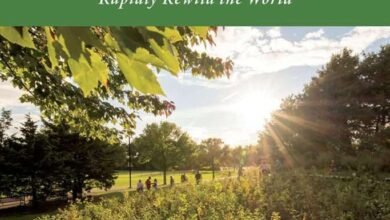Conservation Minded Design for Adirondack Subdivisions Still Rarely Employed


 Ecologist and land use planner George Davis and his staff at the Commission on the Adirondacks in the 21st Century wrote in the Commission’s final report in 1990 that “rising land values and increasing costs of land ownership are making it difficult for forest and agriculture-based industries to withstand development pressures. The trends of large and small subdivision of the [Adirondack] Park are there in the landscape to see.”
Ecologist and land use planner George Davis and his staff at the Commission on the Adirondacks in the 21st Century wrote in the Commission’s final report in 1990 that “rising land values and increasing costs of land ownership are making it difficult for forest and agriculture-based industries to withstand development pressures. The trends of large and small subdivision of the [Adirondack] Park are there in the landscape to see.”
“The APA [Adirondack Park Agency] estimates that some 21,000 single family homes and 6,500 vacant lots have been added in the Park between 1967-1987 – a 43 percent increase over those 20 years,” the report continued. “In the face of this process to fragment the forests and subdivide the lands along the roadsides and lakeshores, the APA Land Use and Development Plan for the privately held lands will not save the Adirondack forests as a sustainable economic base for long.”
The Commission noted in 1990 that Resource Management (RM) and Rural Use (RU) lands comprised 87 percent of the Adirondack Park’s private land, were mostly forest, and made up the bulk of open space essential to the Park’s character. Would the existing APA Act and Land Use plan protect these big open spaces? No, answered the Commission.
Davis also reported that the Adirondack Park Agency was only reviewing, at most, fifty percent of the approximately 1,000 new construction projects built each year.
The Residents Committee to Protect the Adirondacks followed up the Commission report with its own research led by Peter Bauer. In 2001 RCPA found that, regardless of recessionary or inflationary trends in the country, real estate development on Adirondack private lands held steady; nearly 1,000 new principal buildings were still being built annually throughout the Park between 1990 and 2000, again with only half or less of that development reviewed by APA.
APA’s Overall Intensity Guidelines could, mathematically at least, permit 156,000 new homes in RM and RU, continually fragmenting the Park’s private forests and forest management while eroding its open space character.
This information led to the Commission’s three-part strategy for private land use: 1. purchase of conservation easements; 2. zoning changes; 3. transfer of development rights to remove most building pressure from RM and RU and transfer that pressure to Hamlet, Moderate Intensity and Low Intensity.
Strategies 2 and 3 have not been accomplished. However, under strategy 2 conservation easements, which restrict development while retaining private ownership, the Commission’s vision has been significantly realized as more than 800,000 acres under easement have been acquired since 1990, mostly from former pulp and paper companies, now private equity, forest-holding companies like Lyme Timber, in the process reducing the mathematically allowed new housing number on lands zoned green and yellow (Resource Management, Rural Use) by some 20,000.
Still, under the APA Act over 130,000 new principal buildings could be constructed on these most protected private land classes.
One of the many benefits of an improved APA website is that we now can view the permits the Agency issues monthly. There are two years of permit data now up on the APA website, covering
2023 and 2024. They reveal that in the two years prior to 2025 APA has issued 75 permits for 146 new houses in Resource Management and Rural Use, and issued subdivision permits for an
additional 120 new lots.
Assuming that these numbers hold, over the course of ten years APA is likely to permit a minimum of 730 new homes in RM and RU. In addition, they will authorize, at minimum, 600 new subdivided lots in these most protected private land classifications, RM and RU, where many additional new homes will eventually be built.
That is on top of the permits and subdivided lots issued by APA in Hamlet, Moderate Intensity and Low Intensity, where most development pressure is supposed to be steered under the APA’s law, and on top of the many other permits not issued by APA, perhaps reviewed by local governments.
Nor am I considering Parkwide commercial development, including solar installations. Based on APA 2023-24 permits, it seems clear that well over 1,000 new principal buildings are still being constructed in the Park on an annual basis.
How much more than 1,000 annually? APA’s GIS system should be able to provide a pretty good estimate – and as the Park’s land use planning agency, APA ought to report on these and other trends.
“Continuing a trends analysis should be a high priority” APA staff wrote in 2001. Clearly, it wasn’t. A framework for collecting data to detect natural and cultural resource trends in the Park begun in 2000 was never followed-up. Twenty-five years later and during a climate crisis, APA trend analysis on its website is stuck with same 2001 framework.
APA staff talent and technological know-how can do a whole lot better than this – assuming they are expected, tasked, and staffed to undertake the work. They are beginning to do trends analysis for solar installations. That’s a good start. But without tracking, interpreting, and communicating all key Park-wide trends, APA and the rest of us are flying blind.
Where are these new homes and other permitted buildings being constructed? That’s very key because thanks to Adirondack ecologists, such as Dr. Michale Glennon, we know that the spatial arrangement of new structures and roadways on the landscape, far more than the sheer number of structures, determines whether these areas remain habitable for sensitive species of wildlife.
Development sprawl due to bad design which spreads impacts breaks up the land, fragments useful forests, blocks wildlife movements, and sharply reduces species diversity as well as human recreational opportunity. Concentrating development near infrastructure can reduce development costs while preserving large tracts of ecologically and recreationally important open space.
These twin goals ought to be a very important annual task of both APA and local government planners.
This was aspirational, if not well defined and prescribed, 50 years ago. According to the APA Act Resource Management land is to be managed to “protect the delicate physical and
biological resources, encourage proper and economic management of forest, agricultural and recreational resources and preserve the open spaces that are essential and basic to the unique character of the park.”
As for residential development, “resource management areas will allow for residential development on substantial acreages or in small clusters on carefully selected and well-designed sites,” the APA law states. The same carefully selected and well-designed site language applies to Rural Use areas.
Yet, of the 75 new home permits in RM and RU issued by APA during 2023 and 2024, I could not find any which explicitly considers the acreage, clustering, or careful design of new home locations among the permit conditions.
Yes, the house, garage, and septic tank footprints were located out of wetlands, and away from shorelines of rivers and ponds, but none of the permit conditions were assigned to protect delicate physical and biological resources, or to safeguard economic management of forests, or to preserve open spaces basic to the Park’s character – as the law requires.
While most of the permits issued in RM were for one single family home, according to Glennon’s and Dr. Heidi Kretser’s research even one home and roadway located in a sensitive location in an Adirondack matrix forest can spread negative ecological impacts one-eighth of a mile on all sides. It is called the Ecological Impact Zone, and APA staff used to refer to it – but not recently.
The recent permits issued in Rural Use were for 2, 3, 4, 6, 7 and up to 8 principal buildings and a greater number of accessory structures, on acreages ranging from 2 acres to 540 acres. Too many of these permits appear as gridded-out lots which is the unfortunate normal in the United States but under the APA Act, subdivision permits here should not resemble Anyplace USA.
Judging from the site plan maps provided, it appears to me that most of the applications contained adequate acreage, sufficient resource concerns, and legal basis in the legislated purposes of RM and RU lands for a careful design and siting of home and roadway locations.
A modest resource inventory and analysis of open space and water resources and what was living or growing on the site might have triggered conservation design strategies. APA staff
used to pay overt attention to such resource considerations in their permit findings of fact and conditions.

 There is plenty of precedent for this in past APA permits such as subdivisions purposefully negotiated and designed to avoid large resource impacts, including to adjacent Forest Preserve. I refer to the 2004 Persek subdivision permit in Horicon, the 2017 Barile permit in North Elba, the 2012 Highland Farmers subdivision in Keene, to name some examples.
There is plenty of precedent for this in past APA permits such as subdivisions purposefully negotiated and designed to avoid large resource impacts, including to adjacent Forest Preserve. I refer to the 2004 Persek subdivision permit in Horicon, the 2017 Barile permit in North Elba, the 2012 Highland Farmers subdivision in Keene, to name some examples.
Judging from the permits issued over the past two years, it is apparent that none of today’s APA’s leaders are expecting their staff to pay similar attention to careful design of residential development in RM and RU areas.
Of the 75 permits issued for new home construction in RM and RU in 2023-24, just one was considered to have regional impacts sufficient to bring it before the full Agency for its review and approval. The other 74 permits were issued administratively by the staff.
Conservation design and development expert Randall Arendt told the APA during a 2013 conference at Paul Smith’s College that “I look forward to returning to the Adirondack Park when conservation development is the mandate and the norm, not the exception.”
I don’t think he has returned since. Conservation development of APA subdivisions remains the rare exception, not the rule.
For more background information, see “Adirondack Park at a Crossroad: A Road Map for Action,” and “Pathways to a Connected Adirondack Park: Practical Steps to Better Land Use Decisions,” both available at www.adirondackwild.org.
Illustrations, from above: Portion of the APA Land Use and Development Plan Map, 2023; and APA’s Barile subdivision permit in North Elba exhibiting use of conservation design principles.
Source link




